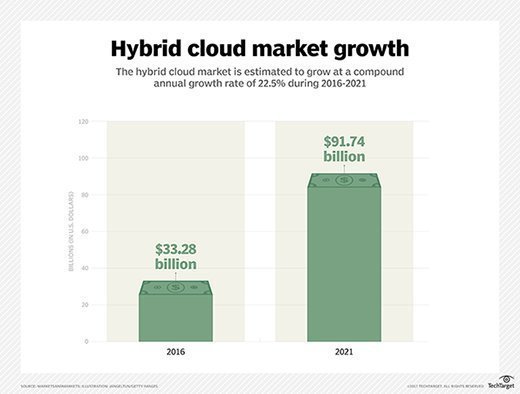AWS, Microsoft and Google push on with hybrid cloud strategies
As enterprises' appetite for hybrid cloud grows, the rivalry between AWS, Microsoft and Google will increasingly revolve around on-premises environments.
Initially, public cloud growth stemmed largely from the demand of startups, particularly content and social media companies. But now, enterprise demand has spurred the of hybrid cloud technologies based on cloud-native services and tools.
Cloud providers that already have data center platforms tend to have more enterprise appeal in this market, which is why Microsoft has an early advantage. AWS and Google need a strategy to blunt that advantage, as well as a way to address hybrid applications that involve serverless computing.
Here's a look at the hybrid cloud strategies from these three IaaS providers and what enterprises can expect next.
Microsoft
Microsoft's hybrid strategy centers on Azure Stack, a platform that extends Azure functionality to on-premises data centers and can run almost everything that runs in Microsoft's public cloud. Azure Stack already includes support for serverless computing as well.
To add to this base layer, Microsoft offers workflow and orchestration management tools. The most basic one is Azure Service Bus, which provides application integration capabilities, including for hybrid cloud apps. Microsoft augments this with its API management tool to simplify service distribution and migration in hybrid cloud strategies. This combination is already popular with enterprises, which gives the provider a near-term advantage.
To make sure it doesn't lose that advantage, Microsoft also added two more services to support hybrid event processing; one is related to event management and distribution and the other to orchestration:
- Azure Event Grid: As the event-driven equivalent of Service Bus, this tool distributes events to processes, including serverless functions.
- Azure Logic Apps: This tool orchestrates events into sequences of processes. It creates stateful apps out of stateless behaviors and has connectors that let almost anything Microsoft provides -- as well as many third-party applications -- trigger events or receive event triggers.
![hybrid cloud market growth]()
Hybrid cloud continues to grow.
AWS
AWS isn't ready to throw in the towel on hybrid cloud, and its VMware partnership has helped it create a foothold on premises. It's clear that AWS' goal isn't to catch up to Microsoft, but to jump ahead. To do this, AWS will continue to target improved integration between cloud-hosted and on-premises application components.
Amazon also has its own workflow tools, based on notification and message queues, such as Simple Notification Service and Simple Queue Service. Enterprises can use all of these tools with AWS applications and integrate them with whatever software or process they use -- such as a message queue -- to connect their cloud and data center environments.
Additionally, AWS Lambda can extend to on premises -- via Greengrass -- and Step Functions provides orchestration for serverless components, including those in the cloud and in local data centers. In short, AWS continues to offer enterprises ways to bridge cloud services with their on-premises environments.
Google had, until recently, lagged behind the other major cloud providers in terms of hybrid cloud but jumped all-in with Google Cloud Services Platform. When combined with Kubernetes, the platform makes it possible for enterprises to deploy applications -- particularly microservices -- more seamlessly from the data center to Google's public cloud.
Arguably, Google Cloud Services Platform moves the provider into second place behind Microsoft for hybrid cloud support. This is because Cloud Services Platform creates a potential for on-site hosting of Google services, which Microsoft also has with Azure Stack. Amazon, to a certain degree, offers this opportunity via its VMware partnership and with tools like Greengrass, but the options aren't as extensive.
Furthermore, users can fairly easily adapt Google's Kubernetes-centric orchestration approach to hybrid and multi-cloud models -- a benefit that's more difficult for AWS and Microsoft to achieve, as Google built its hybrid strategy from the ground up with Kubernetes.
In terms of serverless, Google does support serverless functions, similarly to AWS and Microsoft, but has fewer tools to integrate those functions into a hybrid model.
Hybrid cloud strategies of the future
These cloud providers can take their hybrid cloud strategies in two directions. One is to provide actual hosting capabilities in both the data center and cloud and facilitate integration and cloud bursting. The other is to create a cloud application framework that will work well with on-premises systems and focus more on a static distribution of applications. Microsoft has supported both models from the start. Google continues to move to support both. But AWS is still more focused on the second approach.
With two of its competitors on the opposite side, in terms of hybrid cloud direction, AWS can only follow their lead. Most likely, it will take the same route as Google and create a portable cloud platform that will extend its reach into the data center -- perhaps through its partnership with VMware. If and when that happens, every major cloud provider will be squarely behind a hosting model that treats cloud and on-premises environments as equals.








